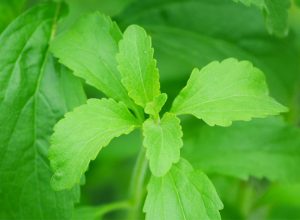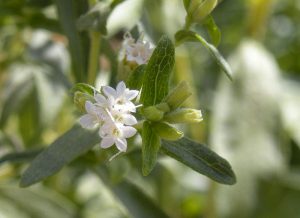Sugar Plant – Stevia Rebaudiana


The Sugar Plant is a small evergreen semi herbaceous plant, of which its spread is alleged to be the result of political and economic boycotting, and as with the Smallanthus Sonchifolius –yacon. We are certain that in the next few years we will be hearing a lot about, even from those who are not really interested in plants, flowers and similar. It belongs to the vast Asteraceae family, very important from an economical point of view: as with the sunflower (Helianthus Annuus), the artichoke (Cynara Scolymus), the chamomile (Matricaria chamomilla), together with many ornamental species like the chrysanthemum, the daisy (Chrysanthemum leucanthemum) and many more still.
Originally from the Western and Northern regions of Mato Grosso do Sul, on the borders of Paraguay and Brazil, this shrub exhibits itself as a small bush of about half a metre in height which as an adult plant is noted because it is full of branches which start from the base and are woody but soon after become herbaceous. At first sight it reminds us of Roman mint: the leaves alternate colour between light green and silver with slightly serrated edges. If it is isolated, the bush can be tidily shaped. It is a plant which does not like the cold, if temperatures fall below zero, it can lose the aerial part, but it will reshoot the following Spring. In very cold climates it should be protected by mulching. It prefers to be exposed to the sun, but in a fresh context: it will do well in a flowerbed in full sun in the middle of the lawn, but it’s not a good idea to plant it in a , as flowerbed surrounded by paving stones or asphalt in that it will make it difficult to regain the herbaceous part.
TERRAIN
The Sugar Plant is not a demanding plant, it is important that the soil is worked, soft and well drained, it is ideally planted in a flower bed. It grows well in a pot which is recommended in regions where the climate is very cold. With the approaching cold it’s possible to move the pot to a sheltered area.
It likes a PH neutral soil, but also if it tends to be acid or basic limestone it develops without problem
FLORA AND FRUIT
I’m not certain the flowers reflect the fruit it gives,The flowers appear in late Summer in small bunches on the tips and from the first 4/6 leaves of every single branch and bloom in stages. They are white, very small with five petals and very distinct on the pointed tips which surround the anthers, and being white, are very visible.
After flowering, at the beginning of Autumn small black or dark brown seeds appear the contents of which is white. The fruit has no organoleptic value.
USE AND HEALTH GIVING PROPERTIES
We have come to the political-economic suspects. From the Sugar Plant you obtain a sweetner, which is 300 times superior to the common sucrose, inappropriately this is called sugar. Make this important premise, we will briefly describe the use of Sugar Plant and its health giving properties.
Used by the populations in the plant’s zones of origin as a sweetner, and in all of South America, that amounts to thousands of people, the Sugar Plant arrived in Europe at the beginning of the 1900s, but only during the course of the second world war, in England, studies of its properties commenced in an effort to make up for sugar shortages. At the end of the conflict they did nothing more. At the end of the 50s/60s in Japan the use of some synthetic sweeteners was banned and in the meantime derivatives of the sugar plant were approved. From then on in Japan, as in all oriental regions of Asia, including China, the derivatives of the Sugar Plant were used daily and had reached a consumption equal to that of the common sugar: that is 50% of the sweeteners used in Japan and Oriental Asia are derived from the Stevia Rebaudiana (Sugar Plant).
In Europe and Northern America, however, products derived from the Stevia Rebaudiana were right up until 2011, held guilty of carcinogenicity.
After strong insistence, or perhaps after the sugar multinational and those of alternative preparatives found a solution. The European Commission, presided over by President J:M: Barroso, sitting on 11 November 2011, deliberation n1131/2011 approved the use of derivatives from the Stevia Rebaudiana (Sugar Plant) regulating the use and quantatives and classifying the products themselves under the heading sweeteners E960 to E959 inclusive (Neohesperidin DC), E961 (Neotame) and E962 (Aspartame Salt) where “E” signifies: food additive authorized and conditions of their use under the food category – sweeteners.
These products derived from Stevia Rebaudiana are the steviol glycosides. Without entering into the specific merits of steviol glycosides because we are not certain as to which level we can speak, that these are a varied group of natural substances of which the main ones are Stevioside, Rebaudioside (A;B;C;D;E) and Dulcusite A and B). These enigmatic names from the site in question, are taken such and such, but will have their importance to follow.
Apart from a powerful sweetener the steviol glycosides have another very to the metabolized by the organism and therefore do not interfere with the blood glucose levels. This is all to the advantage of diabetics who are forced to sweeten their food with synthetic products certainly not very tasty.
Using the steviol glycosides instead of sugar or fructose, it has been ascertained to help contain tooth decay in that the same, do not provoke decay but contribute to a better oral hygiene.
Ideal for hyper calorific diet and for those who are intolerant to glucose, apart from having an anti-inflammatory, antibiotic and antioxidant effect.
Preparations based on steviol glycosides exist commercially, but at the moment, when we acquire them we should pay attention to the contents: the stevioside sweetener has 250/300 times more than sucrose, the Rebaudioside has 350/400 times more than sucrose: we have to check that the elements are pure without added co-formulas or additives. Often the commercial product is advertised as zero calories per dose, but checking the nutritional information we discover that the quantity per 100 grams is almost that of the very common and very good Nutella.
It is much more simple to order the plants from PRANDINI’S GARDEN NURSERY CENTRE. When these are grown, twice a year, you should cut the grassy branches, tie them in a bunch, and hang them in a dry place which is not ventilated and above all, in shade. Once they are dry, pick the leaves, which have more sweetening power, and place them in a well closed container where they will maintain their characteristics for 2/3 years. To use – take the dry leaves and finely blend, then use as you would sugar. The blended product, used to sweeten, doesn’t melt, therefore microscopic pieces of the minced leaves will come into contact with the taste buds, but this is not irritating in any way, but accentuate the sensation of sweetness. This marked sensation of sweetness, apart black. from being pleasant, gives the sense of feeling full. A benefit to those who are on a diet.
Having much more sweetening power than sucrose or common sugar, using stevia Rebaudiana, means measuring the dose well to avoid having an over sweetened food or beverage.
POTTING PRUNING AND CULTIVATION
Potting, as seems obvious, is done twice a year, cutting down the branches to a few centimeters above the ground, so as to be able to collect and dry the leaves.
Fertilization – if the soil is fertile, is not necessary, but if you need to fertilize, mature manue is okay, or as an alternative, a ternary fertilizer low in azoto complete with microelements. In this case, the azoto could make the plant too vigorous causing a reduction in the steviol glycosides and consequently to sweetening power.
Being a prevalently herbaceous plant, you should pay attention to watering, especially if the plants are in full sun.
Parasite attacks-worthwhile to say, there are none, the plant could be attacked by root rot if the soil is too draining. Other fungi which could easily strike the Stevia Rebaudiana if not planted in an ideal position, are Septoria Steviae and Sclerotinia Sclerotiorum. Once these fungi have attacked the plant it is recommended to cut down the infected part immediately. It is not recommended to intervene with chemicals given the final use.
